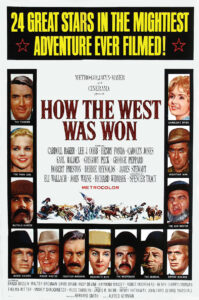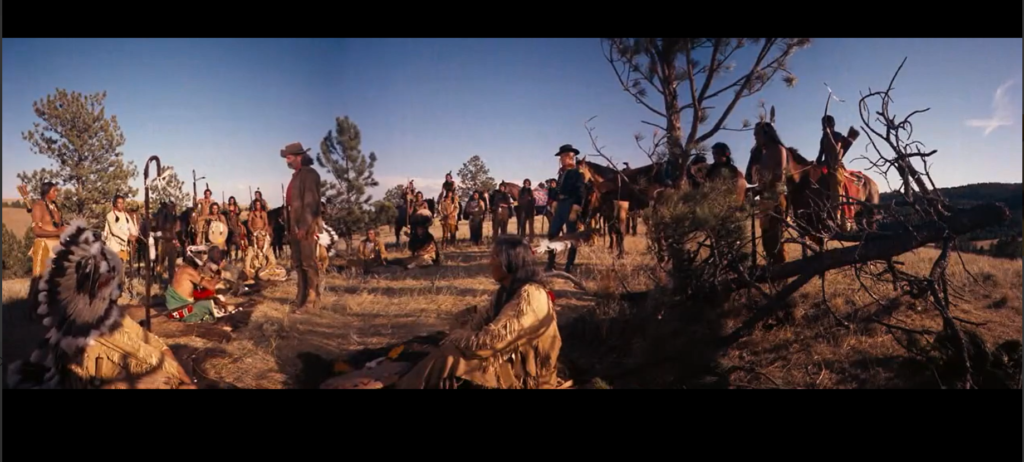|

Synopsis:
Shortly after escaping robbery and death by a river pirate (Walter Brennan) and his clan, a homesteading couple (Karl Malden and Agnes Moorehead) drown in a tragic accident, and their daughters Eve (Carroll Baker) and Lilith (Debbie Reynolds) take different life paths in life: Eve marries and settles down with a mountain man (James Stewart), while Lilith becomes a riverboat singer courted by both an earnest businessman (Robert Preston) and a charming gambler (Gregory Peck). During the Civil War, Eve’s grown son Zeb (George Peppard) and a fellow soldier (Russ Tamblyn) accidentally cross paths with Generals Sherman (John Wayne) and Lee (Henry Morgan). Upon arriving back home, Zeb and a buffalo hunter (Henry Fonda) try to help broker peace with local Native American tribes while a greedy capitalist (Richard Widmark) will stop at nothing to get cross-country railroads built. Finally, while hoping to peacefully settle down with his wife (Carolyn Jones) and kids on land purchased by his widowed Aunt Lilith (Reynolds), Peppard ends up helping a sheriff (Lee J. Cobb) ambush an old enemy (Eli Wallach) plotting a train robbery.
|
|
Genres, Themes, Actors, and Directors:
- Agnes Moorehead Films
- Carolyn Jones Films
- Carroll Baker Films
- David Brian Films
- Debbie Reynolds Films
- Eli Wallach Films
- Ensemble Cast
- George Marshall Films
- George Peppard Films
- Gregory Peck Films
- Henry Fonda Films
- Henry Hathaway Films
- Jimmy Stewart Films
- John Ford Films
- John Wayne Films
- Karl Malden Films
- Lee J. Cobb Films
- Lee Van Cleef Films
- Richard Widmark Films
- Robert Preston Films
- Russ Tamblyn Films
- Spencer Tracy Films
- Thelma Ritter Films
- Walter Brennan Films
- Westerns
Review:
Divided into five chronologically distinct episodes — The Rivers (1839, d: Henry Hathaway), The Plains (1851, d: Henry Hathaway), The Civil War (1861–1865, d: John Ford), The Railroad (1868, d: George Marshall), and The Outlaws (1889, d: Henry Hathaway) — this sprawling western adventure (narrated by Spencer Tracy) was one of only two narrative films made using the innovative but highly challenging shooting technique of Cinerama (the other was The Wonderful World of the Brothers Grimm [1962]). Surprisingly, there’s a solid continuity to the five vignettes: we feel a sense of investment emerging for the family we’re introduced to in the first episode, as the characters all either age or die off realistically. Reynolds and Baker are appropriately feisty as the lead females whose adventures and/or children ground the stories, and the vast supporting cast of big-name actors are fun to spot in a variety of roles (not all of which could be easily elucidated in the lengthy synopsis above). Meanwhile, the cinematography is truly impressive — especially knowing the lengths to which directors Hathaway, Ford, and Marshall (and their crew of DPs) had to go simply to achieve any given scene (check out Wikipedia’s article for more information).
Redeeming Qualities and Moments:
- Impressive Cinerama cinematography


Must See?
Yes, for its historical significance.
Categories
Links:
|
3 thoughts on “How the West Was Won (1962)”
⭐️⭐️⭐️⭐️ out of ⭐️⭐️⭐️⭐️
I agree with the assessment entirely. A genuine classic and a must see for all film buffs, especially in Cinerama if you can where it’s truly spectacular. At home, watch it on Blu-ray (BD) in the Smilebox format on the biggest display you can and it’s still impressive. The standard widescreen format is still great as well.
Not must-see – though it’s of value to those who have a particular interest in US history.
The film’s strongest aspect is the assured direction by Hathaway, Ford and Marshall – in tandem with the often-impressive photography. The performances are serviceable without being standouts – but that’s mainly because the dialogue is somewhat on the dry side and it stays that way throughout.
It’s convenient to have several significant chapters of history together in one film but, at the same time, FFs who have already seen quite a few films that break down the same territory may find the material familiar with little by way of enlightening angles. (That said, the sequence in the 5th section involving the train robbery attempt is particularly well-handled.)
This film’s significance is for being only one of two fiction films made in Cinerama; both are terrific with the other being The Wonderful World of the Brothers Grim. And, both were made in 1962.